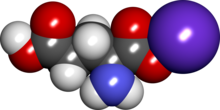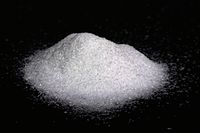
Back غلوتامات أحادية الصوديوم Arabic ملح صينى ARZ مونوسودیوم قلوتامات AZB Глутамат натрыю Byelorussian Глютамат натру BE-X-OLD Мононатриев глутамат Bulgarian ဟန်ႏအိုအွီႏဖွန်ႏ BLK মনোসোডিয়াম গ্লুটামেট Bengali/Bangla Glutamat monosòdic Catalan Ê-só CDO

| |

| |

| |
| Names | |
|---|---|
| IUPAC name
Sodium 2-aminopentanedioate
| |
| Identifiers | |
3D model (JSmol)
|
|
| ChemSpider | |
| ECHA InfoCard | 100.005.035 |
| EC Number |
|
| E number | E621 (flavour enhancer) |
PubChem CID
|
|
| UNII | |
CompTox Dashboard (EPA)
|
|
| |
| |
| Properties | |
| C5H8NO4Na | |
| Molar mass | 169.111 g/mol (anhydrous), 187.127 g/mol (monohydrate) |
| Appearance | White crystalline powder |
| Density | 322 |
| Melting point | 232 °C (450 °F; 505 K) |
| 740 g/L | |
| Hazards | |
| NFPA 704 (fire diamond) | |
| Lethal dose or concentration (LD, LC): | |
LD50 (median dose)
|
16600 mg/kg (oral, rat)[1] |
Except where otherwise noted, data are given for materials in their standard state (at 25 °C [77 °F], 100 kPa).
| |
Monosodium glutamate (MSG), also known as sodium glutamate, is a sodium salt of glutamic acid. MSG is found naturally in some foods including tomatoes and cheese in this glutamic acid form.[2][3][4] MSG is used in cooking as a flavor enhancer with a savory taste that intensifies the meaty, savory flavor of food, as naturally occurring glutamate does in foods such as stews and meat soups.[5][6]
MSG was first prepared in 1908 by Japanese biochemist Kikunae Ikeda, who tried to isolate and duplicate the savory taste of kombu, an edible seaweed used as a broth (dashi) for Japanese cuisine. MSG balances, blends, and rounds the perception of other tastes.[7][8] MSG, along with disodium ribonucleotides, is commonly used and found in stock (bouillon) cubes, soups, ramen, gravy, stews, condiments, savory snacks, etc.
The U.S. Food and Drug Administration has given MSG its generally recognized as safe (GRAS) designation.[9] It is a popular misconception that MSG can cause headaches and other feelings of discomfort, known as "Chinese restaurant syndrome". Several blinded studies show no such effects when MSG is combined with food in normal concentrations, and are inconclusive when MSG is added to broth in large concentrations.[9][10][11] The European Union classifies it as a food additive permitted in certain foods and subject to quantitative limits. MSG has the HS code 29224220 and the E number E621.[12]
- ^ Pinto-Scognamiglio, W.; Amorico, L.; Gatti, G. L. (1972). "[Toxicity and tolerance to monosodium glutamate studied by a conditioned avoidance test]". Il Farmaco; Edizione Pratica. 27 (1): 19–27. ISSN 0430-0912. PMID 5059711.
- ^ "Questions and Answers on Monosodium glutamate (MSG)". www.fda.gov. U.S. Food and Drug Administration. 19 November 2012.
MSG occurs naturally in many foods, such as tomatoes and cheeses
- ^ "Monosodium glutamate (MSG) – Questions and Answers". Government of Canada. 29 January 2008. Retrieved 20 May 2018.
- ^ Agostoni C, Carratù B, Boniglia C, Riva E, Sanzini E (August 2000). "Free amino acid content in standard infant formulas: comparison with human milk". Journal of the American College of Nutrition. 19 (4): 434–8. doi:10.1080/07315724.2000.10718943. PMID 10963461. S2CID 3141583.
- ^ Ikeda K (November 2002). "New seasonings". Chem Senses. 27 (9): 847–49. doi:10.1093/chemse/27.9.847. PMID 12438213.
- ^ Hayward, Tim (22 May 2015). "OMG I love MSG". Financial Times. Nikkei. Archived from the original on 10 December 2022. Retrieved 5 March 2016.
- ^ Loliger J (April 2000). "Function and importance of Glutamate for Savory Foods". Journal of Nutrition. 130 (4s Suppl): 915s–20s. doi:10.1093/jn/130.4.915S. PMID 10736352.
- ^ Yamaguchi S (May 1991). "Basic properties of umami and effects on humans". Physiology & Behavior. 49 (5): 833–41. doi:10.1016/0031-9384(91)90192-Q. PMID 1679557. S2CID 20980527.
- ^ a b "Questions and Answers on Monosodium glutamate (MSG)". U.S. Food and Drug Administration. 19 November 2012. Retrieved 4 February 2014.
- ^ Obayashi, Y; Nagamura, Y (17 May 2016). "Does monosodium glutamate really cause headache?: a systematic review of human studies". The Journal of Headache and Pain. 17 (1): 54. doi:10.1186/s10194-016-0639-4. PMC 4870486. PMID 27189588.
- ^ Wei, Will (16 June 2014). The Truth Behind Notorious Flavor Enhancer MSG. Business Insider (Podcast). Retrieved 13 November 2017.
- ^ "Current EU approved additives and their E Numbers". Food.gov.uk. 26 November 2010. Retrieved 30 January 2012.
© MMXXIII Rich X Search. We shall prevail. All rights reserved. Rich X Search
